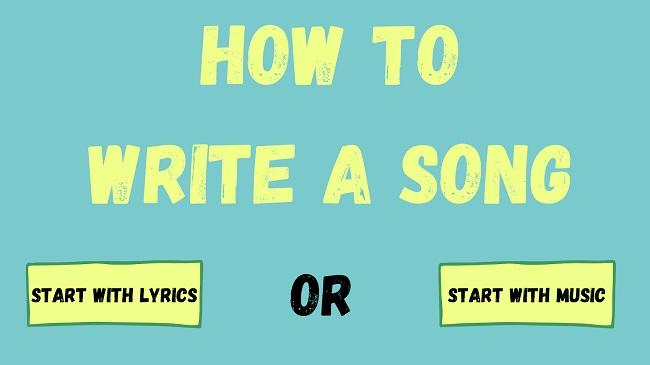It’s important to examine your songwriting process, whether you’re just starting out or have created a lot of songs already, to see if there are methods to improve or better organize your work.
Here, we’ll take a look at how professional songwriters create music, and we’ll lay out a system that anyone can use to create their own tunes. In addition, I will recommend some excellent educational resources for songwriters and provide some practical advice for improving your songwriting abilities.
Many songwriters assert that the ability to compose music is a rare gift you’re either born with or you aren’t.

Although a certain degree of natural ability is necessary, songwriting is a skill that can be taught and learned. The existence of music degrees at the university level is evidence of this. Learning songwriting could help you hone your skills and make the most of your potential as a musician.
Contents
How to Make a Song
These ten helpful hints are used by great songwriters every day when writing new music and lyrics.
1. Compose a Catchy melody
The same three- and four-chord progressions are used in countless tunes. How come certain tunes have a way of staying in our brains for days? Perhaps the tune holds the key. The melody is the most crucial component of songwriting if you want to create an earworm.
Most effective melodies progress in whole- or half-step increments, with occasional leaps (increases or decreases of any larger interval). They also typically feature a focal point, or a prominent note that serves as the melody’s foundation.
2. Use All Types of Chords
Sticking to the same few chords will restrict your musical creativity. Create a more complex and fascinating sound by using major, minor, dominant, diminished, and augmented chords into your songwriting.
3. Create a Memorable Rhythm
The most memorable songs, from country radio staples to underground hip-hop classics, often have an instantly recognizable rhythmic theme.
Take note of how a funky or syncopated melody or background track might be the most memorable component of a song the next time you listen to your favorite songs, and use that knowledge to inject originality into the rhythm of your own compositions.
4. Build your Song Around a Riff
Riffs that serve as the song’s backbone can be written by anyone, regardless of whether they play an instrument.
From Tom Morello’s funk-metal guitar lines on Rage Against the Machine’s “Bombtrack” to the Timbaland-produced synth lick on Jay-Z’s “Dirt Off Your Shoulder,” riffs can be the song’s saving grace. Because of this, they are among the most useful instruments for composing music.
5. Write a Song You Can Play Live
With the use of modern music production tools, composers may now compose entire digital symphonies in the comfort of their own homes. Even though digital audio workstation (DAW) software is fantastic for creating music, you should also plan for live performances.
The executives at record labels want to see how musicians perform in front of live audiences, so make sure your music is equally as captivating in concert as it is on record.
6. Step Away From Your Instrument to Write
It makes sense to sit at a keyboard or guitar and hum while you compose music. Though effective generally, this strategy runs the risk of having you write songs that rely too heavily on tired cliches.
Put down the instrument, step outside, and try composing some music in your brain. Singing your ideas into a smartphone’s voice recorder is a great way to capture them. Now that you know the songs, it’s time to go back to your instrument and learn how to play them.
7. Get Ambitious with Song Structure
An introduction, a verse, a pre-chorus, a chorus, a bridge, instrumental solos, and a coda or outro are typical components of a song. Make it a goal to go beyond the standard verse-chorus format in your next song. Try at least following the standard song format of verse / chorus / bridge / chorus. This structure is used by many modern pop hits.
8. Approach Your Lyric-Writing with Both Structure and Spontaneity
Lyric writing is difficult. Keep some room for unexpected discoveries in your lyric writing process. Like a poet, you should learn to wait for the lyrics to arrive, even if you have a general idea of what the song will be about or have written a few lines of lyrics. Some lines may captivate you solely due to their pleasing consonance or assonance.
9. Use Rhyme as a Tool
Song lyrics that have a consistent rhyme system tend to be more memorable, singable, and catchy. However, lyricists don’t have to rely on rhymes exclusively. In cases where rhyming would be ineffective, one should instead focus on conveying the idea.
10. Learn to Break Through Writer’s Block
Changing up your routine might be a terrific strategy to break through writer’s block. Do you usually compose the music and then the words? Flip the order and see if it helps. Do you often start by strumming chords and then adding your own improvised melody?
Put the guitar down and think of a tune or riff to play. Experiment with composing a song with an unknown instrument or style. Leaving your usual routine might be a great way to stimulate your imagination.
Conclusion
The songs of skilled songwriters evoke strong feelings in their audiences and leave a lasting impression. The craft’s tools and procedures aren’t there only to drive us nuts or inspire us to compose shallow, unoriginal songs in a rote fashion; they have a purpose. Songwriters have used them for centuries because they help audiences connect with and recall a song’s central theme.






![Err_Connection_Reset Error in Chrome [RESOLVED] Fix Err_Connection_Reset Error in Google Chrome](https://howandwow.info/wp-content/uploads/2019/09/Fix-Err_Connection_Reset-Error-in-Google-Chrome.jpg)
![DNS_Probe_Finished_No_Internet Error [RESOLVED] Fix DNS_Probe_Finished_No_Internet Error](https://howandwow.info/wp-content/uploads/2019/09/Fix-DNS_Probe_Finished_No_Internet-Error.jpg)
![Err_Cache_Miss in Google Chrome Error [RESOLVED] Err_Cache_Miss in Google Chrome Error](https://howandwow.info/wp-content/uploads/2019/08/How-to-Fix-Confirm-Form-Resubmission-Error.jpg)









![Steam Missing File Privileges Error [RESOLVED] How to Fix Steam Missing File Privileges](https://howandwow.info/wp-content/uploads/2020/07/How-to-Fix-Steam-Missing-File-Privileges-Error-100x70.jpg)
![SIM Not Provisioned MM#2 Error [RESOLVED] SIM Not Provisioned MM#2](https://howandwow.info/wp-content/uploads/2020/03/SIM-Not-Provisioned-MM2.jpg)








